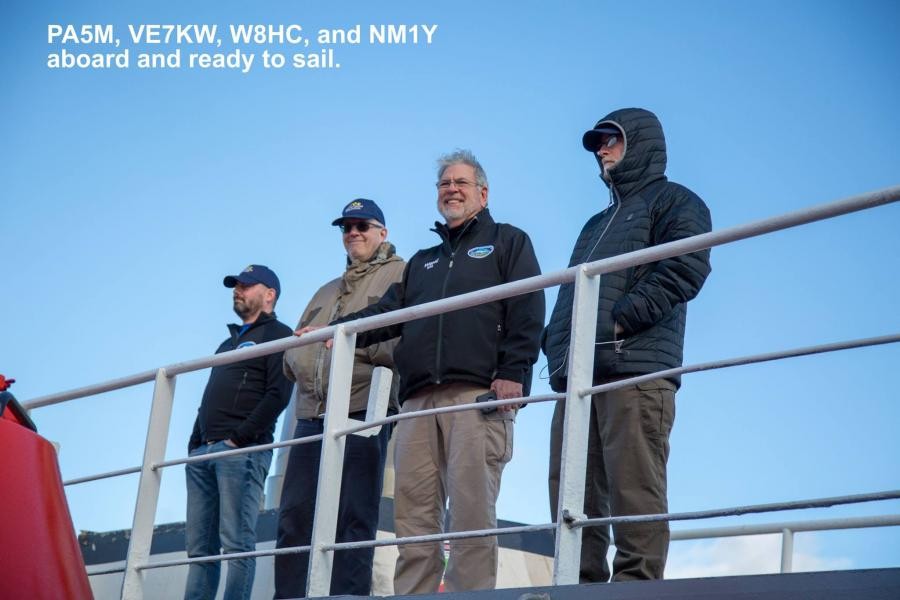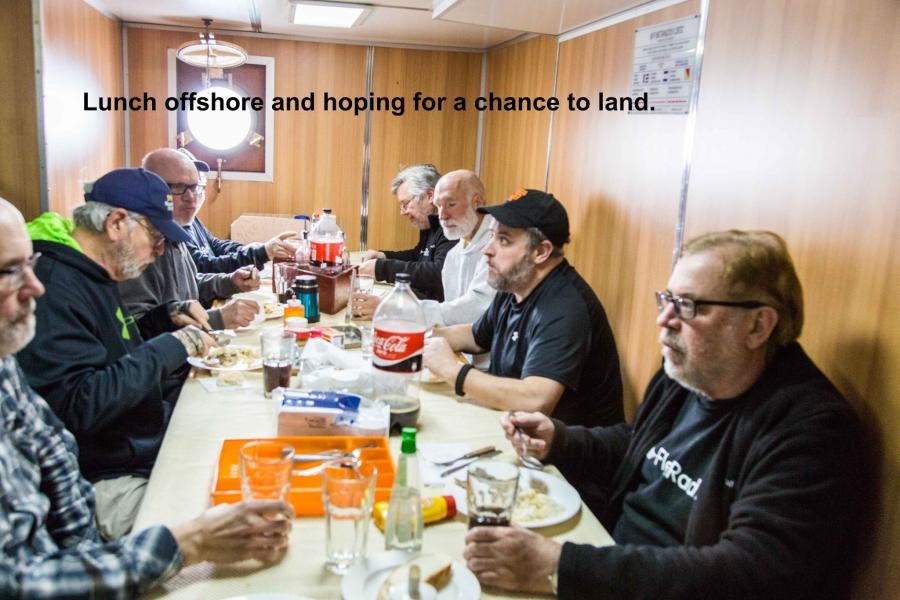3Y0Z Story from Ralph Fedor K0IR
The Voyage:
On January 19th vans picked us up at the Yellow Submarine Hotel and took the team and our luggage to our ship. We were processed through Customs and Immigration and taken to the pier where the Betanzos was moored.
The vessel lay there listing to starboard by about 5 degrees. Helicopters had been landed on the vessel, had their blades removed, and were covered in protective black canvas. Barrels of gasoline for our generators and over 3,000 gallons of JP-1 fuel for the helicopters took up most of the space on the main deck. A few ceremonious toasts celebrated the maiden voyage of the newly refurbished vessel, tugs moved the Bentanzos away from the pier, and we were underway.
We sailed eastward in the Magellan Straits, watched Punta Areans fade into the horizon, and then entered the open ocean. We passed to the south of the Falkland Island and then on January 24th sailed along the north coast of South Georgia. I have visited both of these islands previously. South Georgia with its rich history, magnificent scenery, and abundant wildlife is truly one of the most unique places on our planet.
Once past South Georgia, things began to change. Temperatures dropped, the wind increased, the seas became rougher, northerly drifting icebergs appeared, and points of failure began revealing themselves. Although it was relatively quiet on one afternoon, a great commotion and ruckus erupted in cabin one. It seems that during the ship’s refurbishing, two ends of a fresh water line had not been connected and when the crew began swabbing the deck water gushed out of the ceiling of cabin one. Two very wet and very surprised occupants emerged and water surged over the door lip and down the hallway. On a particularly rough night, brackets securing furniture to the floor failed. Couches, chairs, and tables broke loose and flew about the room breaking off various parts. And a little later, a new leak appeared.
As we neared Bouvet, we sorted the equipment in our containers, staging it for landing. Other problems with the ship manifested themselves, like water shooting upward out of the toilets at inopportune times; a particular problem for those dealing with severe seasickness. Through it all, the Flex radios and the coax and antennas from DX Engineering were there for our maritime mobile operation as we passed through the rare maidenhead grid squares of the Southern Ocean.

From https://www.facebook.com/ralph.fedor.1
The Voyage:
On January 19th vans picked us up at the Yellow Submarine Hotel and took the team and our luggage to our ship. We were processed through Customs and Immigration and taken to the pier where the Betanzos was moored.
The vessel lay there listing to starboard by about 5 degrees. Helicopters had been landed on the vessel, had their blades removed, and were covered in protective black canvas. Barrels of gasoline for our generators and over 3,000 gallons of JP-1 fuel for the helicopters took up most of the space on the main deck. A few ceremonious toasts celebrated the maiden voyage of the newly refurbished vessel, tugs moved the Bentanzos away from the pier, and we were underway.
We sailed eastward in the Magellan Straits, watched Punta Areans fade into the horizon, and then entered the open ocean. We passed to the south of the Falkland Island and then on January 24th sailed along the north coast of South Georgia. I have visited both of these islands previously. South Georgia with its rich history, magnificent scenery, and abundant wildlife is truly one of the most unique places on our planet.
Once past South Georgia, things began to change. Temperatures dropped, the wind increased, the seas became rougher, northerly drifting icebergs appeared, and points of failure began revealing themselves. Although it was relatively quiet on one afternoon, a great commotion and ruckus erupted in cabin one. It seems that during the ship’s refurbishing, two ends of a fresh water line had not been connected and when the crew began swabbing the deck water gushed out of the ceiling of cabin one. Two very wet and very surprised occupants emerged and water surged over the door lip and down the hallway. On a particularly rough night, brackets securing furniture to the floor failed. Couches, chairs, and tables broke loose and flew about the room breaking off various parts. And a little later, a new leak appeared.
As we neared Bouvet, we sorted the equipment in our containers, staging it for landing. Other problems with the ship manifested themselves, like water shooting upward out of the toilets at inopportune times; a particular problem for those dealing with severe seasickness. Through it all, the Flex radios and the coax and antennas from DX Engineering were there for our maritime mobile operation as we passed through the rare maidenhead grid squares of the Southern Ocean.

From https://www.facebook.com/ralph.fedor.1




Comment